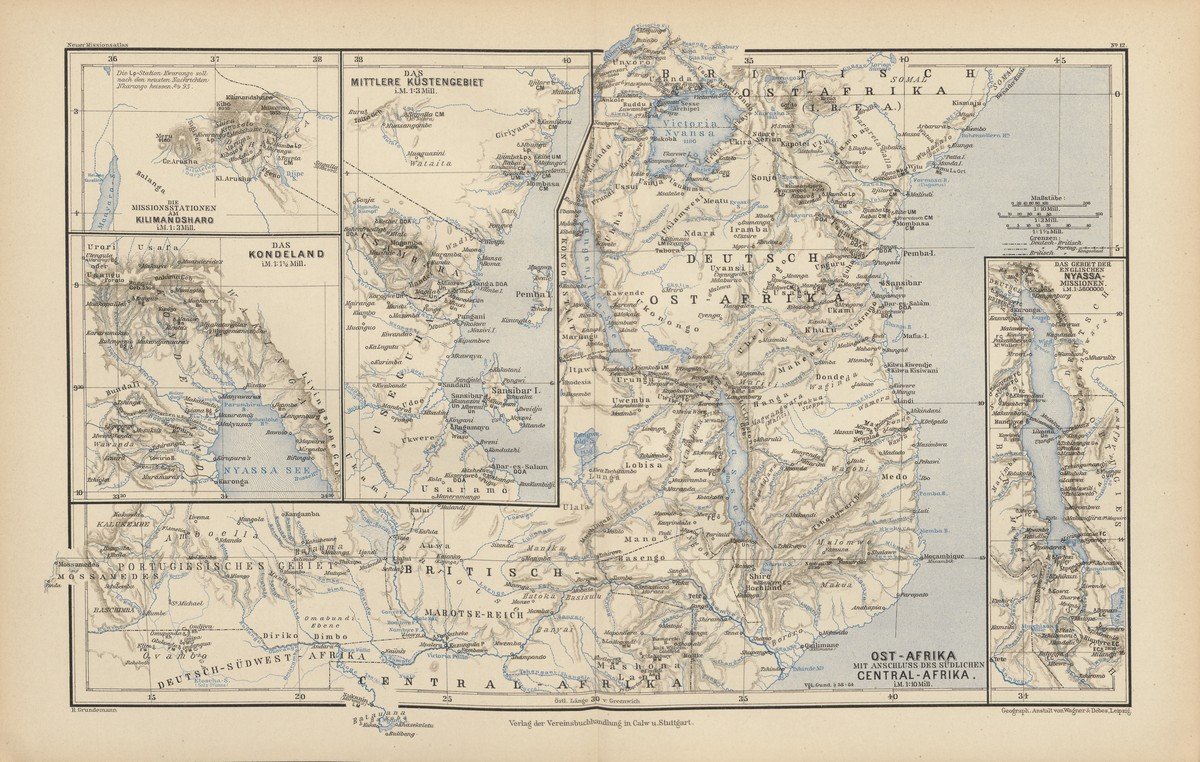'Ost-Afrika mit Anschluss des Südlichen Central-Afrika'. In: 'Neuer Missions-Atlas', 1896
This 1896 map shows German colonial possessions in East Africa, nowadays in Burundi, Rwanda and Tanzania, with four inset maps (area around Kilimanjaro, two maps of Lake Nyasa and one of the coastal area around Zanzibar). Mission stations are marked by abbreviations such as LP (Leipzig Mission), DOA (Evangelische Missionsgesellschaft für Deutsch-Ostafrika) and CM (Church Missionary Society).
The map clearly shows the intertwining of imperialism and missions in this period. The Leipzig Mission, for example, was initially in favor of an international approach to missions, but under pressure from the German government to consolidate the colony in East Africa, non-German mission organizations were slowly but surely expelled. This map shows how the Leipzig Mission slowly but surely took over mission stations from the English CMS in the Kilimanjaro area. Reinhold Grundemann (1836-1924) probably refers to this in his remark that he processed information for that area ‘according to the latest news’ (of September 1895). Four German mission organizations dominated the African colony: the Leipzig Mission, the Moravian Church, the Berliner Mission, and the Evangelische Missionsgesellschaft für Deutsch-Ostafrika.
The map was published in the New Missionary Atlas of all evangelical missionary territories, with special attention to German missions by Grundemann, which appeared in 1896. This atlas contains 12 maps of Africa, 13 of Asia, 5 of America and 5 of Oceania. Grundemann was a prolific theologian who brought about the professionalization of missionary cartography. He produced a number of very high-quality missionary atlases, especially in comparison with the earlier, sometimes simple maps. Grundemann had studied theology in Tübingen, Halle, and Berlin, and became a minister in 1861. His interest in missions and cartography led him to undertake missionary and study trips, where he collected material for the General Missionary Atlas, which is divided into four volumes and which appeared between 1867 and 1871. A smaller version, the Minor Missionary Atlas to present the evangelical missionary work according to its current state, appeared in 1886, and a revised atlas, the New Missionary Atlas, in 1896. Typical of Grundemann was the more scientific approach and precision of his maps. For example, where earlier maps only marked ‘heathen’ territory, Grundemann made a distinction between eight variants of nature religions.
This was the third atlas Grundemann made (the first appeared in 1867). In the preface, he indicated that he had hoped his labor would have found more imitation: ‘I must admit that for years I have hoped to find successors in the mapping of missions, younger shoulders on whom I could shift the burden of the work.’


